The risk sentiment broke out. Why did the gold and silver oil fall across the board?
On Tuesday (May 9), after the French election, the market focus turned to economic growth and monetary policy. The market risk sentiment exploded: the US dollar strengthened across the board, and the yen, gold and silver and crude oil spot gold and silver fell to the US$16/bbl mark. The decline continued with the US oil and oil both fell more than 1%... When the market fell into a tragic fall, Bitcoin stood out, rising above $1,700, up nearly 90% from the same period last year.
The risk sentiment broke out, the dollar rebounded, and the yen and gold and silver oil fell together.
In the US market, the US dollar index strengthened across the board, rising to 99.61, the highest level since April 24, after the French election, the market focus returned to monetary policy and economic growth.
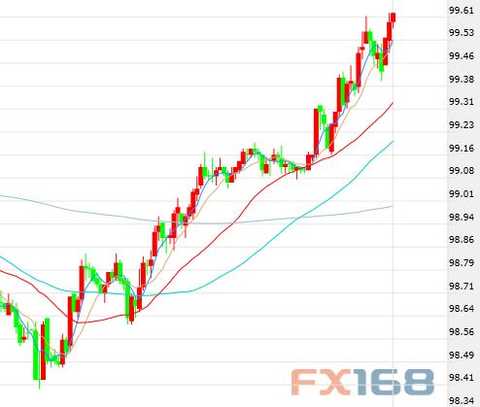
US index 30 minutes chart, source: FX168 financial network
After the release of the non-agricultural report on Friday (May 5), the market's eyes began to turn to the Fed to observe how they would look at the future rate hike path after analyzing a series of recent data.
Cleveland Fed President Meister said on Monday that the Fed must "keep a high degree of vigilance" behind the rate hikes that are needed.
“If the delay is too long to take the next normalization step, we will be at risk of recession,†Meister told the Chicago Global Affairs Committee.
Meister pointed out that the Fed has reached an inflation target of nearly 2% and has achieved employment goals, and it is likely to need further interest rate hikes. On the issue of shrinking the table, she also believes that the Fed needs to solve the balance sheet problem, but now the risk of the US economy and inflation is “roughly balancedâ€, so the balance sheet is allowed to naturally narrow.
At the same time, St. Louis Fed President Brad said that the US economy seems to be in a low growth state, reaffirming that the Fed does not need to raise interest rates. He believes that the Fed's current interest rate policy is appropriate.
Federal Reserve George Rinet said that the weak GDP in the first quarter is not the reason for the Fed to stop gradual interest rate hikes. The unemployment rate overshoot will bring risks to economic expansion. She expects that delays in raising interest rates will pose risks and thus support a gradual rate hike. She also reiterated that the Fed should start shrinking this year.
Some analysts pointed out that the speeches of Fed Eric Rosengren and Robert Kaplan this week may further provide direction for the dollar.
However, Deutsche Bank's latest article said that the impact of short-term interest rate growth on the US dollar exchange rate is becoming more limited, so the US dollar forecast at the end of 2017 is adjusted accordingly.
In other currencies: the yen fell the worst! USD/JPY climbed sharply, reaching a maximum of 114.22, the first time since March 15 that it has risen above the 114 mark.
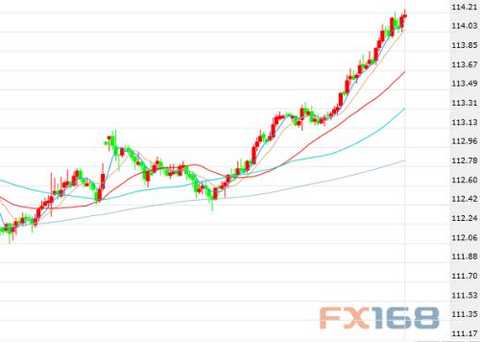
(USD/JPY 30-minute chart, source: FX168 Financial Network)
JPMorgan analyst Daniel P Hui pointed out that the bank also increased its long position of USD/JPY due to expected global yields continuing to rise.
It also pointed out that the interest rate market expects the rate hike probability in June to exceed 75%, and the US dollar performance still lags behind the interest rate spread, indicating that the USD/JPY still has room to rise based on the Fed's interest rate hike prospects.
In addition, technical analysts also believe that the exchange rate is currently in the fifth wave of rising waves, the target points to the 118 mark. From a fundamental point of view, the US-Japan policy deviation will provide support for the exchange rate.
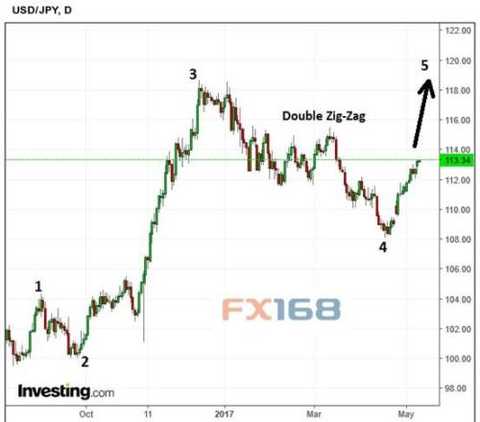
(Source: Investing.com)
However, the bank also said that the exchange rate risk comes from fundamentals and commodity prices. The fall in commodity prices will benefit the yen, as Japan’s resources are scarce and goods and resources are heavily dependent on imports. However, the spread may still be the main driver of the exchange rate.
In addition, the euro/dollar continued to fall, once fell below 1.09, the lowest at 1.0870; GBP/USD followed the euro's decline, the lowest fell to 1.2900; USD/CHF continued to climb, rising to a new high of 1.0076 since April 17.
Technically, the 200-day moving average of the EUR/USD is still a key support, after the high level has been above the moving average. If it falls below, the euro/dollar will face the risk of covering the gap after the first round of elections in France.
As interest in dollar buying continued and risk sentiment prevailed, spot gold and silver expanded, with gold falling for five consecutive trading days to a two-month low of $1215.99 per ounce, and silver renewing its January 4 low to $16.07 per ounce.

(Spot gold 30 minutes chart, source: FX168 financial network)
The most active June gold futures contract of COMEX was 7247 lots in Beijing, 22:19-22:21, and the total value of the trading contract was nearly 900 million US dollars.
Under the pressure of huge sell orders, the price of gold has fallen below the 100-day moving average today, trading under the collapse of the post of Mark Long on Sunday.

(Source: ZeroohedGE, FX168 Financial Network)
The gold/silver ratio hovered above 75 and rose to the top of the Brexit referendum.

(Source: Zerohedge, FX168 Financial Network)
Mark Long’s victory in the French election and the Fed’s interest rate hike are expected to continue to boost the dollar and the stock market. Market risk sentiment has subsided and gold is under pressure. The market's interest in riskier assets has also pushed global stocks to record highs, while the market's so-called fear index, the VIX volatility index fell to its lowest point since 1993.
UBS analyst Joni Teves said: "The biggest political risk event has now been eliminated, and there are some consolidations in the market that make sense. Although political uncertainty may last for a while in Italy, further pressure cannot be ruled out. However, we expect bargain hunting and the purchase of physical gold will be strengthened. The price of gold should be tested at $1,200 per ounce, paving the way for a rebound."
Danish bank analyst Jens Pedersen said: "Before the next Fed meeting, the gold market entered a tight month. The market is raising interest rates for June, pushing the US high yield and the dollar higher, which is driving down the price of gold."
FXStreet pointed out that under the circumstances that the US lacks economic data that can cause significant market trends, the recent Fed monetary policy outlook will remain the key determinant of the short-term trend of gold. Therefore, the market will focus on today's Boston Fed President Rosengren and Dallas Fed President Kaplan, which may bring fresh stimulation to the market.
Crude oil and gold once again become "difficult brothers and sisters." US WTI crude oil fell below US$46/barrel and fell more than 1%. Cloth oil fell below US$49/barrel and fell 1.2% in the day.
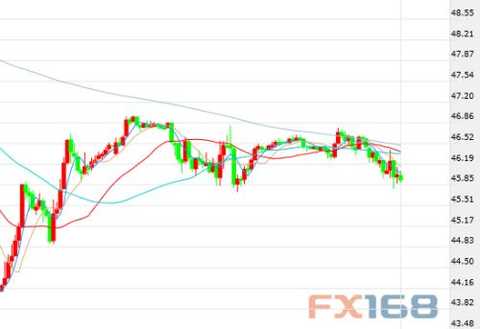
(US oil 30 minutes chart, source: FX168 financial network)
Concerns about a slowdown in demand and a continued rise in US crude oil production have weakened the OPEC's potential to increase the impact of production cuts.
Traders said that the United States continued to push up crude oil production, especially the output of shale oil producers, undermining OPEC's efforts to tighten the market and support oil prices, which led to pressure on the oil market.
Since the middle of 2016, US crude oil production has increased by more than 10% to 9.3 million barrels per day, close to Russia and Saudi Arabia.
“This makes it difficult for inventory to fall to levels that OPEC believes will keep oil prices rising,†said Greg McKenna, chief market strategist at futures broker AxiTrader.
Goldman Sachs said that they have “basically changed†the oil industry, given that US shale oil drillers have the ability to increase production at a much faster rate than traditional producers.
Goldman Sachs also pointed out that in view of the lack of important crude oil data released in the past two days, we believe that there are two main factors leading to oil price selling: 1) the continuous sharp decline in copper prices and iron ore prices; 2) the re-impact of technical and warehouse positions, This time mainly due to the negative impact of time arbitrage liquidation.
Bank of America Merrill Lynch said that another reason for the low oil price is the slowdown in demand.
"This year's oil demand growth is general, partly explaining the reasons for the recent sharp drop in crude oil prices and refining margins," Bank of America Merrill Lynch said.
The best currency of the year: Why is Bitcoin so bullish?
In the past 18 days, Bitcoin recorded an increase in the 16th, which surged nearly 50% last month, and has soared nearly 90% so far in 2017, making it the best performing currency this year.
According to industry website Coindesk, bitcoin prices have climbed above $1,700 on Tuesday and are now trading near $1713.66.

(Bitcoin daily chart, source: Coindesk, FX168 financial network)
In recent weeks, this digital currency has risen rapidly. According to Coindesk data, bitcoin has risen 43% in the past month. In the past year, the market value of Bitcoin has also increased significantly, from $7.16 billion in May 2016 to $27.9 billion today. According to the website price index, its market value has soared by more than $1 billion in the past 24 hours alone.
The CNBC author pointed out that the recent developments in events continue to support its gains. Japan’s decision to use Bitcoin as a legal payment method has made it more popular, and the yen’s influx of bitcoin demand has increased. According to Chris Burniske, an analyst at ARK Invest's blockchain product, supply and demand dynamics have also had a huge impact on this digital currency.
Last summer, the supply of Bitcoin created a halving annual growth rate. This is an automated process that was written into the Bitcoin code when it was invented in 2008 to reduce supply every few years to prevent inflation.
“This means that the bitcoin being minted in 2017 will be half of the first half of 2016,†Burniske told CNBC by email.
“The reduction in supply expansion is coupled with the fact that bitcoin is more used as a means of exchange and value storage, either at a higher rate or at a price that has to adapt to market dynamics.â€
Zerohedge believes that the trend behind today seems to have not been triggered by specific catalysts, because Japan's interest in Bitcoin has increased and Russia is considering allowing it to be a legitimate means of payment. These messages were rejected by the SEC and Chinese bitcoin prices. The collapse has been overshadowed.
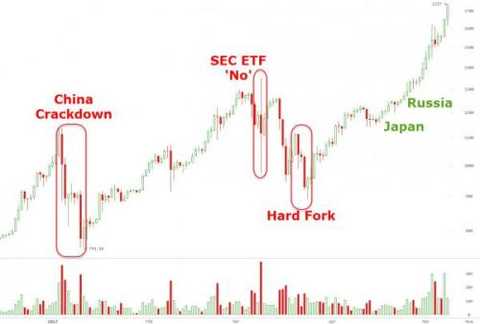
zhejiang leima shoes ind.co.,ltd , https://www.safetyshoeschina.com